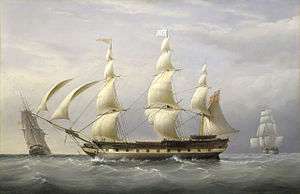West Indiaman
West Indiaman was a general name for any merchantman sailing ship making runs from the Old World to the West Indies and the east coast of the Americas.[1] These ships were generally strong ocean-going ships capable of handling storms in the Atlantic Ocean.[2] The term was used to refer to vessels belonging to the Danish (e.g. Æolus), Dutch, English, and French (e.g. Indispensable) West India companies.

Similarly, at the time (18th & 19th centuries) people also referred to East Indiamen (ships trading with the East Indies), Guineamen (slave ships), or Greenlandmen (whalers in the North Seas whale fishery).
British West Indiamen tended to be London-built and to sail directly from England (generally London), to the West Indies. Guineamen tended to be built (or owned) in Bristol and Liverpool, and to sail from Bristol or Liverpool via West Africa in what is now often referred to as the triangular trade.[3] Obviously, there were London-based Guineamen (see for instance Experiment), and Liverpool-based West Indiamen (see for instance Irlam and Irlam).
Often the same vessel would move between roles and routes over the course of her career as entrepreneurial owners chased profitability. Thus Fame started and finished as a West Indiaman, but in between made a voyage for the British East India Company (EIC) as an East Indiaman and two voyages as a Guineaman. Holderness made one voyage as an East Indiaman for the EIC, then several as a Greenlandman, and ended up a West Indiaman.
Citations and references
Citations
- "West Indiaman". Merriam-Webster.com. Retrieved 27 June 2014.
- "West Indiaman ship". Portcities London. Retrieved 27 June 2014.
- Tibbles (2005), p. 33.
References
- Tibbles, Anthony (2005) Transatlantic Slavery: Against Human Dignity. (Liverpool University Press). ISBN 978-0853231981